Alternative Futures: Biofuels and Mass Spectrometry
LCGC North America
The use of mass spectrometry to study biofuels is examined and the advantages and disadvantages are explored.
In the 1950s, petroleum-related gas chromatography–mass spectrometry (GC–MS) applications were one of the founding cornerstones of modern MS. Even now, "petroleomics" — not to be outdone by life science research — serves as an example of the cutting edge in liquid chromatography–mass spectrometry (LC–MS) (1). In petroleomics, high order MS techniques can differentiate between chemical species that differ by less than the mass of a single electron. Such astonishing precision has come about as the magnetic-sector mass spectrometers of previous decades have yielded their place to modern, time-of-flight mass spectrometers, improving the utility and flexibility of analyses with high mass accuracy and resolution.

Michael P. Balogh
The Time has Arrived
War in the middle east and Asia exacerbates fuel and heating oil shortages in the United States, heralding the end of an era of inexpensive oil. The stock market (with the exception of oil stocks) stumbles badly, and following the president's authorization of controls on oil prices, production, and allocation, the secretary of state announces a national plan to make the country "energy independent." You could be forgiven for assuming that, except for the last two items, I am recounting news of 2008. Yet the United States' president was Richard Nixon, and it was during his tenure in the early 1970s that oil prices went from slightly more than $3 a barrel to nearly $12. Later in that decade, the country faced a resurgence of energy-related issues. As the decades passed the United States' national energy policy is still a work-in-progress.

Because it requires little cultural adaptation on the part of us humans, blending novel power-generating technologies with renewable energy sources would seem more promising of success. But even here, besides the considerable technological hurdles involved in developing alternative energy supplies, those who promote change encounter cultural resistance. Among the nontechnology issues that plague us are lawsuits brought by abutters who find wind machines problematic for aesthetic and other reasons, interest groups for whose members abandoning the status quo would cost money, the relatively high cost of the new technologies, and geographical restrictions on wind, thermal, or solar generation of electricity on any useful scale. Wave farms for instance, planned for the coast of the state of Rhode Island (Oceanlinx, Australia), would consist of 10–14 floating cable-tethered units each unit 90 ft long, 60 ft wide reaching a height of 30 ft above sea level.
In December 2008, 120 windmills — the largest of Europe's onshore facilities — went online in Portugal. The total output is 650 GW hours per year, or 1% of the country's total energy needs — enough to provide power to about 300,000 homes (2). A relatively poor country by Western European standards, Portugal is already recognized for its unique, commercial wave-power plant, though the plant has been, so far, slow in meeting expectations (3).
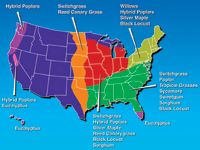
Figure 1: Commonly used plant species in the United States are viable for widespread growth. (Figure courtesy of Russ Miller at ORNL from Bioenergy Feedstock Development Program Status Report, ORNL/TM-2000/92, Model woody and herbaceous crops chosen for study in the 1990s.)
To date, the world's largest onshore wind farm, the Horse Hollow Wind Energy Center, is located in the United States, in Texas, and it provides more than 700 MW (4). Portugal is less than one-fifth the size of Texas, and its population, less than half that of Texas (10.6 million versus 23.5 million) is far more dense. Its goal of achieving more than 30% of its power generated by new technologies by 2020 is commendable (according to the Guardian article cited here, that figure is more than twice the amount planned for the U.K.). Nevertheless, the cost of new projects is substantial, and it looms as a frequent issue in technology development discussions. In this instance, the Portuguese government supplies subsidies up to 40% of costs.
Whether for improved batteries, for greater deployment of electricity, or other alternative possibilities for decreasing our global consumption of fossil fuels, the challenges of these technologies are interdependent, and must be addressed together.
The Promise of Bioenergy
The terminology we use to describe a new technology is often imprecise, and it tends to be as changeable as the novel technology is malleable. Biofuel, biodiesel and various other terms often become incorrectly interchangeable as they evolve. One area of endeavor that looks particularly promising in the renewable bioenergy field involve biofuels made from plants. Converting soluble plant sugars into liquid fuels involves deoxygenation: removing oxygen atoms from the raw cellulosic material. Subsequent refining steps create the branched hydrocarbons on aromatic compounds used for gasoline or as longer chains for diesel fuel.
Europe currently leads in biodiesel production where the U.S.has focused on developing ethanol. By some estimates, biodiesel production is expected to reach 12 billion L by 2010, while worldwide consumption of petroleum products escalates 35% by 2025 (5).
Ethanol developed from corn helped institute an E85 gasoline initiative in the U.S. Nevertheless, corn-based ethanol is now giving way to cellulose-based ethanol. Vehicles today can run on 10% ethanol mixed with gasoline. But as of 2006, only six million vehicles registered in the U.S. could run on 85% ethanol — that out of 250,851,833 passenger cars, according to U.S. Department of Transportation's Bureau of Transportation Statistics (6).
Steven Chu, secretary of the Department of Energy, has championed the use of biodiesel, which has initiated an upsurge in the prospects for biofuels, according to reports in BioFuels Digest (7).
Because of the cost volatility of corn, which is the primary source of ethanol in the U.S., the commodity is no longer looked upon favorably as a precursor of biodiesel. Loss from recent storms and increased demand for ethanol production, as well as inequities in foreign exchange rates, fuel this volatility, as prices favor exporting feed. Chu, the head of the Lawrence Berkley National Laboratory and a Nobel laureate in physics, is on record as arguing against the food-crop based ethanol approach (8). A 2007 report commissioned by the governments of China and Brazil called for intensive research into cellulose-based production, which relies upon technology like isolating microbes or using large amounts of heat and steam to break down the tough bits into fuel (9).
How Widespread is the Interest in Cellulose-Based Fuels?
A wealth of information about cellulose-based fuels is posted on the newly developed Oak Ridge National Laboratories website (10). Links, reference data, conversion data, and a glossary make it a key source of information on the topic.

Figure 2: T08024 (top trace) was a batch that showed no detectable monoglycerides. T07032 was a batch that had detectable levels of monoglycerides. (Courtesy Doug Stevens and James Stuart.)
Seeing the topic discussed in Chemical & Engineering News (11–13) on an almost issue-by-issue basis might not surprise us. What is surprising, however, is that automobile enthusiasts are as current with the technology as core researchers, thanks to publications like Motor Trend, which recently made the economic arguments (Whiter Lightning, Frank Markus: Motor Trend, December 2008):
". . . self-seeding perennials require little or no tilling, minimal nitrogen, and no phosphorous or potassium fertilizer. The initial cost to establish these energy crops is estimated at $100–$250/acre but they live 10 years and yield 12–15 tons/acre, making 65–130 gallons of ethanol per acre depending upon the crop and processing method."
A popular magazine seems an unlikely place to find this level of technological and economic detail. That it does indicates two things. First, the need for the technology is imminent, and the effects of that need are felt throughout our population. Second, the processing method mentioned at the end of the quotation indicates we still have work to do.
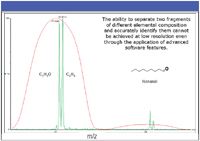
Figure 3: Comparing the improvements gained using a time-of-flight instrument instead of a quadrupole-only design indicates the clear advantage in such complex mixtures.
Besides the DOE-supported consortium, comprising three laboratories (with Chu's Lawrence Berkley National Laboratory in the lead), some universities have long offered programs based upon the history of petroleum research. Several companies are already well-advanced decoding plant genomes and experimenting with gene expression. One of them, Ceres (http://www.ceres.net), of Thousand Oaks, California, currently markets varieties of switchgrass and sorghum. Sold under the name Blade Energy Crops, these bioproducts thrive in various climatic conditions and are designed to meet various biothermal or biochemical processes. The company claims planting energy crops on 40 million acres of idle or marginal farmland can potentially offset half of the gasoline needs of the U.S. It also says that planting those crops builds topsoil and does not adversely affect the country's capacity to produce food, all the while netting five times the energy yield of corn-derived ethanol.
The Department of Energy, in conjunction with the Department of Agriculture, postulates that more than 1 billion tons of biomass could be produced exclusively for energy in the U.S. each year, all with only modest changes in terrestrial crop practices. Considering only the biomass conversion technology available today, that quantity of biomass could replace about 30% of the petroleum consumed by the United States.
Current Practice and Analytical Necessities
Universities have long taken on basic energy research. Jay Keasling, a chemical engineer at the University of California Berkley, is noted widely for his work with yeast to produce the necessary endproducts for both pharmaceutical discovery and energy-development studies. Here again, another article in the popular press highlighted the widespread interest ("Saving the World, One Molecule at a Time," People to Watch: Jay Keasling, Newsweek, Dec 29, 2008). The article notes grants from British Petroleum, among others, underwriting Keasling's work. Keasling is now head of the newly created American Joint BioEnergy Institute and armed with $134 million funding through 2013.
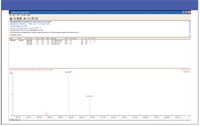
Figure 4: The formula of C27H55O4S2 for the [M+H]+ is consistent with that for mono-linolein TMS, as suggested by the EI data from the monoglycerides standard and accurate mass measurement. Isotope pattern and mass accuracy reinforce each other and strengthen confidence in assignment. (GCâTOF results courtesy of Doug Stevens of Waters Corporation, Milford Massachusetts.)
Head of biodiesel testing at the University of Connecticut and professor emeritus James Stuart and colleagues have been characterizing biodiesel for many years. A number of different vegetable oils are used to produce biodiesel (referred to as ±00) and each feedstock varies by fatty acid concentration and degree of saturation. In testing the stepwise transesterification (using methanol–potassium hydroxide) of the oil's triglycerides often results in the formation of monoglycerides, as incomplete saponification products. The various monoglycerides are eluted close to the desired 24-carbon-length methyl esters, making peak identities problematic. Assigning accurate masses to these mid-eluted peaks would allow positive identification of questionable peaks as undesired monoglycerides or desired methyl esters.
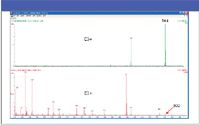
Figure 5: Comparison of an information-rich EI spectrum displaying detailed fragmentation (at the expense of conserving the molecular ion needed to assure identification) with a CI spectrum of the same sample, which conserves the energy to produce the confirming molecular ion.
In his recent presentation at the Eastern Analytical Symposium (November 19, 2008), Dan Walsh, a chemical engineer with Bently Tribology Services (Peabody, Massachusetts) reviewed the realities of producing biodiesel. Most of the test methods and standards were designed for petroleum products. But biodiesel behaves differently. It is more sensitive to in-laboratory environmental factors than petroleum products. Elements of edible oil testing and petroleum testing methods are being refined to address uniqueness of product. For instance, problems that occur in storage and transit arise from no single cause but rather a synergistic effect produced from these conditions:
- Chilling (product B100 has "thermal memory")
- Formation of sterol glycosides
- Elevated moisture
- Near-specification levels of bound glycerin (monoglycerides, diglycerides, triglycerides)
Professor Stuart's experience underscores one of the analytical issues. His GC–flame ionization detection (FID) results, based upon published work with vegetable oil methylesters (VOMEs) and fatty acid methyl esters (FAMEs) (14,15), disagree with current ASTM D6584 (Test Method for Determination of Free and Total Glycerin in B-100 Biodiesel Methyl Esters by Gas Chromatography). The methyl esters of C24, which are supposed to be eluted in the 0.80–0.82 RRT range (in comparison to a tricaprin standard), are eluted in the same range as the various known monoglycerides: near 0.83 min on two different GC columns commonly used in biodiesel research.
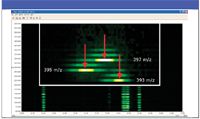
Figure 6: The three coeluted peaks - monoolein, monolinolein, and monolinolenin - are easily distinguishable. So is the presence of trace impurities, using a 3D display.
The method is designed to analyze biodiesel samples for impurities that foul, clog, and cause deposits in engines using biodiesel as fuel. As a quality control measure, the trimethylsilyl (TMS) derivatized forms of monoglycerides, diglycerides, and triglycerides are quantified, ensuring the processing of the raw oils used as feedstock is complete and efficient. The presence of glycerides above a certain level is an indicator of a process failure.
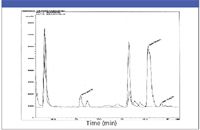
Figure 7: High-temperature GC analysis of canola oil showing the monoolein range expanded. Since one means of characterizing complex mixtures is by "fingerprint" comparison shifts in baseline, the retention time of coelution could be misconstrued as unacceptable glyceride presence. (Figure courtesy of James Stuart.)
This ASTM method consists of a 30-min GC analysis with FID and a special, high-temperature, capillary GC column. Only 0.100 g (eight drops) of the B-100 is weighed. Two internal standards are added, and any free-hydroxyl groups and acids in the B-100 are derivatized at room temperature using N-methyl-N-trimethylsilyltrifluoracetamide (MSTFA) in a pyridine solvent. After a 15-min reaction time, the sample is diluted to 10 mL with n-heptane and 1.0 μL injected. The peaks' relative retention times are then compared with those of the two internal standards. For the B-100 sample to conform to ASTM standards, the amount of free glycerin must be less than 0.020%, and the total glycerin must be less than 0.240%, by mass.
This ASTM method consists of a 30-min GC analysis with FID and a special, high-temperature, capillary GC column. Only 0.100 g (eight drops) of the B-100 is weighed. Two internal standards are added, and any free-hydroxyl groups and acids in the B-100 are derivatized at room temperature using N-methyl-N-trimethylsilyltrifluoracetamide (MSTFA) in a pyridine solvent. After a 15-min reaction time, the sample is diluted to 10 mL with n-heptane and 1.0 μL injected. The peaks' relative retention times are then compared with those of the two internal standards. For the B-100 sample to conform to ASTM standards, the amount of free glycerin must be less than 0.020%, and the total glycerin must be less than 0.240%, by mass.
Making the correct identification of closely related formulas in complex mixtures is among the greater challenges facing the practitioner. Kind and Fiehn covered the topic in detail in a 2008 column (16). Predicting isotopes for given chemical entities is well-characterized and several companies offer software features that compare the theoretical isotope pattern with that of the acquired data, to increase the likelihood of arriving at the correct answer. For instance, Waters' (Milford, Massachusetts) MassLynx iFit algorithm indicates an increasingly better match between the theoretical and measured data with lower iFit ranking numbers. Bruker's (Billerica, Massachusetts) SmartFormula software ranks possible candidates according to a match factor between the measured isotopic pattern and the theoretical pattern for a given formula or sigma value, which should be close to zero.
Resolving the differences between standards and representative samples using electron ionization (EI) and chemical ionization (CI) with isobutane and a variety of comparative tools, like NIST libraries, clearly indicates that when faced with an incomplete process or contamination, the two-dimensional GC–FID data alone is insufficient to indicate the specific source of an interference. Sometimes an acceptable batch result is masked by a deteriorated septum or other casualty of common practice. The resulting reduction of process downtime, along with the prevention of needless batch rejection, means increased productivity and prevents wasteful remedial actions to the process system.
The 3D figure shows another technique, one similar to the use of Krevelen diagram representations for the complex data discussed in Ryan Rodgers' petroleomics work (1).
The relatively broad impurity peak, at 15.64 min, displays the same elemental composition as monoolein TMS, at 15.94 min (the middle peak in the inset). The other two peaks are similar to monoolein but have different degrees of saturation. (Monostearin TMS is shown at 16.20 min.)
The early eluted peak has one more double bond, while the peak eluted later has two more double bonds than monoolein. These peaks are eluted within 1–2 s of each other, but the acquisition rate of 10 spectra/s is sufficient to profile the peaks accurately and reveal the coelutants.
Walsh says in his EAS overview that anyone can make biodiesel, but its quality can vary. Even the ASTM method is a work in progress. Equations 6–8 are not consistent with instructions in the overview's section 9.4.1, which calls for the analyst to "Prepare a calibration curve for each reference component by plotting the response ratios (rspi), as the y-axis, versus the amount ratios (amti), as the x-axis." Current equations in the method plot the reverse: that is, the amount ratio as the y-axis and response ratio as the x-axis. Once updated, test method D6584 will become consistent with section 9.4.1 and also with other ASTM test methods, such as D4815, D5580, etc. in the plotting designation.
Improvements such as Simulated Distillation (now either ASTM D2887 or ASTM D 7391) use GC data that replaces the classical "Distillation of Petroleum Products Under Reduced Pressure" (ASTM D1160) and the calculated Cetane Index uses some of the same GC data to replace the classical ASTM D976 "Cetane Number of Diesel Fuel Oil." Even so, there are common analytical pitfalls that increased analytical capability helps resolve.
Costs and Prospects for Biofuels
In addition to more traditional GC tools currently being employed, the newly opened BioEnergy Center at Oak Ridge National Laboratories has been equipped with an ultrahigh-pressure liquid chromatography (UHPLC) system (ACQUITY UPLCsystem, Waters Corporation, Milford, Massachusetts) with a quadrupole mass spectrometer (Sciex, Life Technologies, Mississauga, Canada), for high throughput quantitation, and a high-definition quadrupole time-of-flight (QTOF) instrument (SYNAPT, Waters Corporation) with ion mobility capability for qualitative development.
Recent work submitted for publication details investigations showing promise for LC using hydrophilic interaction chromatography (HILIC). HILIC was realized to have utility for nucleotides and carbohydrates and highly polar compounds not well-retained by reversed-phase stationary phases like C18. Investigations of cellulosic samples have been extended to monolithic columns as well (17).
Walsh estimates a testing budget of $10,000 per 100,000 gallons produced is required, which equates to an analysis cost of $0.20 per gallon. The full ASTM D6751 test package cost varies yet it is generally expensive, particularly because cetane is required. So the prospects for reduced specifications would result in a less expensive, more flexible analysis. One way to approach a reduced cost while maintaining high-fidelity results might be to extend the utility of the instrument.
One technology to make a recent return is atmospheric gas chromatography — a hybridization of GC with a mass spectrometer designed for LC with electrospray ionization (ESI). Bruker (Bruker Daltonik GmbH, Bremen, Germany) introduced a combination GC–atmospheric pressure chemical ionization (APCI) interface at ASMS 2008 (Denver, Colorado) for the microTOF II model, and Waters has commercialized work developed by Charles N. McEwen (E.I du Pont de Nemours & Company, Wilmington Delaware) (18) introduced for the Xevo source design at Pittcon 2009. Attempts to broaden the applicability of an LC–MS-only design by adding GC in years past sacrificed sensitivity associated with GC analysis. Prerelease results shown with the Xevo APGC design not only combine the analytical attributes of a GC-dedicated instrument (though only in CI mode) but does so with the attributes of LC–ESI-MS, that is, using the same software and conventions (polarity switching for instance) but with sensitivity of a dedicated GC–TOF system.
Michael P. Balogh "MS — The Practical Art" Editor Michael P. Balogh is principal scientist, MS technology development, at Waters Corp. (Milford, Massachusetts); a former adjunct professorand visiting scientist at Roger Williams University (Bristol, Rhode Island); cofounder and current president of the Society for Small Molecule Science (CoSMoS) and a member of LCGC's editorial advisory board.
References
(1) M.P. Balogh, LCGC26(3), 262–276 (2008).
(2) http://www.guardian.co.uk/environment/2008/dec/02/portugal-wind-power
(3) http://www.guardian.co.uk/environment/2007/oct/01/waveandtidalpower.renewableenergy
(5) Global Biofuel Market Analysis, May 2008, RNCOS http://www.marketresearch.com/product/display.asp?productid=1784056&g=1
(6) http://www.bts.gov/publications/national_transportation_statistics/html/table_01_11.html
(8) http://www.agriculture.purdue.edu/agcomm/news/agresearch/Archive/2008/June/index.htm
(9) http://uk.reuters.com/article/environmentNews/idUKTRE4BA72020081211
(11) A. Tullo, Chemical & Engineering News, November 10 (2008).
(12) S. Ritter, Chemical & Engineering News, December 8 (2008).
(13) S. Ritter, Chemical & Engineering News, November 17 (2008).
(14) C. Plank and E. Lorbeer, J. Chromatogr., A697, 461–468 (1995).
(15) W. Tiyapongpattana, P. Wilairat, and P.J. Marriott, J. Sep. Sci. 31, 2640–2649 (2008).
(16) T. Kind and O. Fiehn, LCGC26(2), 176–186 (2008).
(17) K. Horie, T. Ikegami, K. Hosoya, N. Saad, O. Fiehn, and N. Tanaka, J. Chromatogr., A1164, 198–205 (2007).
(18) M.P. Balogh, M.P. LCGC25(4), 368–380 (2007).
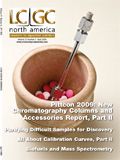
Evaluating the Accuracy of Mass Spectrometry Spectral Databases
May 12th 2025Mass spectrometry (MS) can be effective in identifying unknown compounds, though this can be complicated if spectra is outside of known databases. Researchers aimed to test MS databases using electron–ionization (EI)–MS.

.png&w=3840&q=75)

.png&w=3840&q=75)



.png&w=3840&q=75)



.png&w=3840&q=75)









